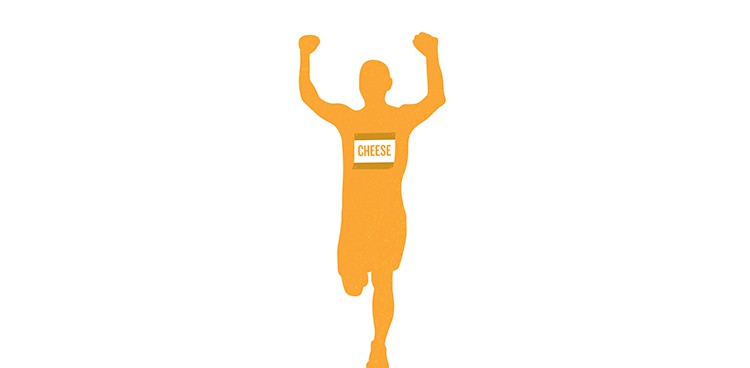
Cheese often gets a bad rap when it comes to nutrition, thanks to decades of (occasionally misinformed) claims from doctors, government agencies, and health gurus. Even the most devoted turophile might adopt a hushed tone when confessing how much cheese he consumes, or even cut cheese from his diet altogether when pursuing a fitness goal.
But do curds deserve their reputation as a guilty pleasure? Max McCalman, celebrated Maître Fromager and author of Mastering Cheese, doesn’t think so. Instead, he often extolls it as “the perfect food.” While I raised an eyebrow the first time I heard him say this, further research has proven the wisdom of his words.
A quick perusal of popular diet plans for runners and other endurance athletes reveals a few nutritional components repeatedly highlighted as essential: proteins, minerals, fats. Cheese, it turns out, is an efficient source of these nutrients and more.
Twenty to twenty-five percent of cheese’s calories come from protein, says Kelly Toups, a registered dietician with Oldways, the parent organization for the Oldways Cheese Coalition. Approximately 20 percent of those calories come from whey—a “quick” form of protein that helps protect muscle during exercise and provides a ready source of energy. The rest comes from casein, a “slow” protein that helps athletes develop strength and stamina over time.
According to the USDA Food Composition Database, the remaining 70 to 75 percent of cheese’s calories come from fat. And before that number scares you away, bear in mind that fat is one of the newest villains-turned-stars of the nutritional world. Unsaturated fat, in particular, is considered healthy, but even saturated fats, found in grass-fed meats, eggs, and yes, that wedge of blue on your board, are getting a reprieve as of late. For vegetarian athletes, in particular, cheese can be an easy way to up protein intake.
In addition, cheese is packed with magnesium and calcium—the former is necessary for healthy muscle contractions and energy metabolism, while the latter helps protect against common overuse injuries, such as stress fractures, and assist with muscle and enzyme function and normal heart rhythms.
Cheese also contains conjugated linoleic acid (CLA), purported to boost metabolism and aid in burning fat (though it should be noted that claims for CLA’s benefits are backed by inconclusive research). Even the high salt content of cheese can be a boon to athletes, since it helps replace vital electrolytes shed via sweat.
Indeed, cheese is a concentrated source of nutrients—you might even think of tyrosine-flecked Alpine cubes or clothbound cheddar shards as natural energy bites or sports goo, delivering a delicious bang for your buck.
Gregg Cook, a personal trainer, and instructor at Equinox Fitness Clubs in New York City known for his high-intensity classes, eats cheese and recommends it to his clients. “As long as the individual doesn’t have a dairy intolerance, [high-quality, artisan cheese is] great,” he says. “Goat cheeses may be some of the best as they generally have a lower-calorie, higher-protein makeup.”
Cook also gives a thumbs-up to fat: “Full fat is definitely better than low fat. Cheese can have a satiating effect thanks to the fat content. However, and certainly not surprisingly, if you overindulge you might put on some weight.”
While cheese is a good addition to a balanced diet, it’s still essential to consume foods across the nutritional spectrum— especially if you’re training for a race or other competitive event. “Carbohydrates fuel your muscles and are the foundation of healthy sports nutrition,” Toups says, citing Nancy Clark’s Sports Nutrition Guidebook. “Athletes who want to include cheese in their eating plan need to be sure to pair it with carbohydrate sources.”
Another caveat: It’s important to test how your stomach responds to cheese—especially during a workout. Of course, this is also true for many otherwise nutritious foods, from leafy greens and other high-fiber items to fatty meats and nuts. There’s a reason a big bowl of pasta has become the carb-loading cliché (think: quick and easy digestion)—add a grating of nutritionally rich Parmigiano Reggiano, and you just might have the perfect fuel.




